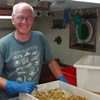General Description
Cephalon and anterior pereon with granules; mandibles symmetrical, with incisors, greater than half length of cephalon; maxillipedal endite broad. Mediofrontal process conical with many notches on lateral margins; paraocular ornamentation not extremely produced; frontal border at most only slightly produced; pereon with anterior constriction on peronite 4. Pleopods subequal. Penes not fused and produced. Up to 3.5 mm long.
Biology
Sea mites lead complicated lives. The juvenile stage, called a praniza, lives attached to the skin of a fish where it feeds on blood and mucus which it obtains with sharp little jaws. The praniza metamorphoses into either a male (recognised by its huge jaws) or a female which broods a clutch of coloured eggs in its thorax. The male maintains a harem of females in a communal burrow in sandy rubble or algae. There are many species of gnathiids in all marine environments in Australia.
Habitat
Sandy sediments, at depths of 11-130 m.
Reefs
Distribution guide
Southern Australia.
Species Group
Depth
Shallow (1-30 m)
Deep ( > 30 m)
Water Column
Max Size
3.5 mm
Diet
Organic matter
Commercial Species
No
Global Dispersal
Recorded in Australia
Species Code
MoV 1607
Conservation Status
- DSE Advisory List : Not listed
- EPBC Act 1999 : Not listed
- IUCN Red List : Not listed






